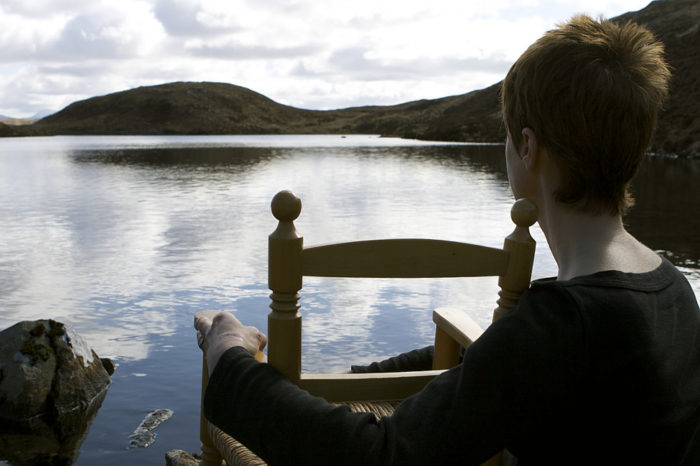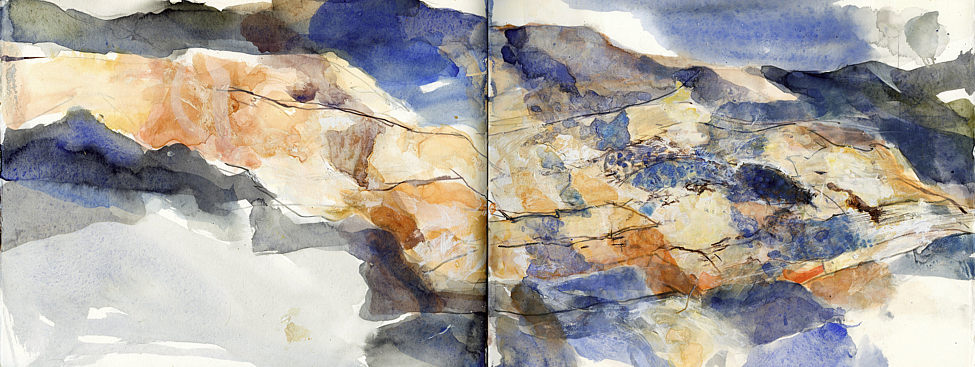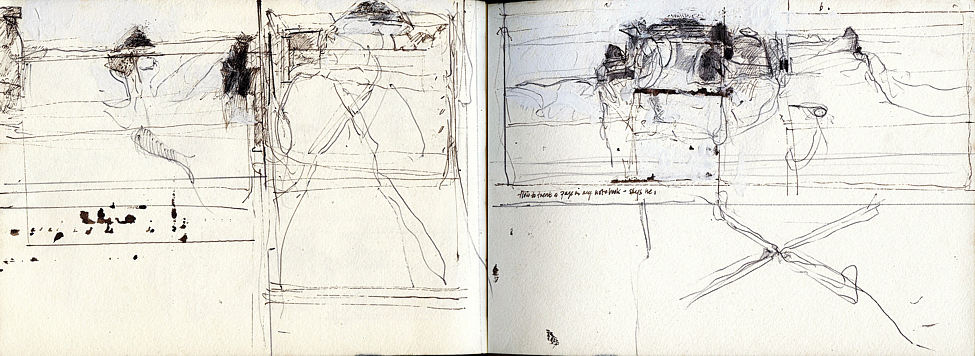LAND2: Mull Transect
What follows here is an evocation - in text and images - of a single collective project that took place over the period of a day.
The site chosen is reached by way of a rough track that runs through a communally-owned larch plantation to reach a small-holding overlooking the sea. Below this small-holding lies an area of dune, sandy beach , rolling banks and rocky outcrop that together form the landscape of a curved bay around the mouth of a small river. The transect ran from the bank of the river to the summit of a steep bank rising above it. Its site was chosen as being, in a number of respects, typical of the environmental diversity found everywhere on the island.
I would like to thank the participants both for their input on the day - the clear sky was due to an arctic wind - and for allowing me to use the material they produced here.
Iain Biggs
Bristol May 2008
Their presentation was converted from PowerPoint to Flash and can be viewed below:-
LAND2: Field Trip April 08

Five nights, four days on the Hebriddean isle of Mull, Western Scotland
Participants:
Iain Biggs, Judith Tucker, David Walker-Barker, Lily Markiewicz, Jane Millar, Gail Dickerson, Ray Lafferty, Claire King, Mel Thompson, Josh Biggs and Suze Adams.
Why Mull for the field trip, what is the link between LAND2 and Mull? The link is me, Suze Adams, the island being home to my maternal ancestors.
Mull was chosen as the location for a field trip partly due to my connection, this personal link and prior knowledge of place, but also due to the richness of the geological history which is so strikingly evident in the topography of the island. The field trip was centred in the north west of the island around the small town of Dervaig. As well as being the focus for a multi-faceted exploration and examination of the locale, the trip was the meeting point for a broad range of approaches and practices all grappling with over-lapping concepts of landscape.
The weather was kind and days were spent outside – walking, observing, investigating and documenting through a diverse variety of media. During the evenings, we shared our various experiences/discoveries/preoccupations across the dining table and later gave informal presentations of our work. The presentations gave us an insight into each other’s practice and provided an opportunity for informed feedback followed by informal discussion.
An initial ‘gut’ reaction to the LAND2 visit to Mull has been provided by each of the participants. These are early markers of our experience of the island and individual pieces will be developed over time. Details of any exhibition of works generated by the field trip will be posted in due course.
Suze Adams, April 08
Iain & Josh Biggs
“We made the long day¹s journey north west, arriving for the first time at the island through a brief curtain of bright rain. Sheep and geese grazed the edge of the sea loch below Dervaig. A grey heron traversed bleached reed beds. I watch us attuning ourselves to a wider sky, a colder, more various light. Almost all such original forest as there was is long gone".
Judith Tucker
Mull in Anticipation and on Arrival
I am looking now at two piles of books which sit on my studio table: the larger consists of all books and maps I began to collect in expectation of the LAND2 visit to Mull: they concern social history, geology, walking, memoirs and tourist guides from different eras; next to them sits a second, much more modest pile: four other books, rather slimmer and more or less devoid of words, these are the sketchbooks I made on location. The contrast between the two piles of books seems to sum up the gap between anticipation and arrival, between one kind of knowledge and another kind. Before, leaving I was thinking about the clearances, poverty, moors, notions of the ruin, depopulation, the rise of tourism in the early twentieth century, the romantic tradition, the theatre of the absurd, the concept of an island, our contemporary relation with and need for wilderness. Needless to say, as soon as I set foot on the ferry at Oban all these thoughts left me, and sheer enjoyment of light, space and colour became paramount. I spent my time on Mull sitting still, getting backache and cramps, and feeling a rather exaggeratedly large sense of achievement each day, having spent hours drawing and painting large expanses of rocky headlands. The activity allowed a kind thinking that can only come through the process of this kind of being in place, the images I produced are secondary. I might only have seen a very small part of Mull and investigated it in one particular, not to say peculiar way, but I feel as if that distant expansive landscape has come close. Now, back in my studio, the two ways of knowing come into conversation with each other and the work I am planning to make will both be a knowing riff on the practice of landscape painting and the tourist gaze while offering respect for the place itself.
Suze Adams

Mull -land of maternal ancestors; a place known and yet unknown, a place where past, present and possible futures coalesce, a place where the conceivable cuts through time.
Mull has been in my consciousness since early childhood; this island that my mother and aunt disappeared to every year, this island always mentioned whenever family gathered, this island full of magical names that kept recurring, names of people and places I could only imagine, people and places that all seemed somehow connected although I could never work out exactly how or why. As I grew older, I grew none the wiser; in fact the ‘story’ of Mull just seemed to get thicker, the plot ever more complicated.
My first visit was made at the age of eighteen; my great aunt and uncle, my mother, aunt, sister and I made the long journey north, the pilgrimage, to Mull. I was taken to meet friends and relatives on the island and on walks where the waterfall flowed ‘faster than ever before’, where the hidden loch was revealed, where the family cairn was saluted, where ‘Grauntie’s stone’ was indicated, where family picnics were relived and where old friends were remembered.
With only my aunt remaining to answer my questions, I have started visiting the island regularly; walking in the footsteps of my ancestors, repeating the tales as I remember them in places that have borne witness to my forebears. The Morisons (one ‘r’) live on; ghosts abound, new legends are borne, myths are passed on as a history of sorts.
David Walker Barker


Barely a Taster
In such a short period of time it was impossible to understand the complex nature of this island landscape. It might take a lifetime to comprehend its breadth of scenery and the intimate details enfolded within that variety. Yet over the course of those few days, with gratitude in part to the weather the clarity of atmosphere and light allowed access to quintessential features. The discovery of abandoned human spaces on the headland at Calgary invested a sense of poignancy into a remarkable and isolated place. Ruined crofts, ancient walls and extensive remnants of field systems evidenced the toil that nurtured this intimate area through generations of un-named people.
Potential Images
Outlines and silhouettes, the stepped shapes of volcanic headlands and the profile of islands shimmering in the distance form an iconography suggesting images that are composite, object, painting and document forming an amplification of memory and imagination.
Claire King
at the machair thinking about the idea of the hook, the line and the catch; the hook and line being used to seek out to search out something valuable have just observed a dust devil, a sandstorm in miniature, I sensed it off to the left after I had turned around and oriented myself with the sun collect scattered dried stems of sea grass, saw a sand caldera and lay down in the sand to examine it more closely, stood up and saw my trace in the sand.
Lily Markiewicz
My interest in landscape has always been guided by my experience as a cosmopolitan with roots in a history of migration and placelessness. I have never been able to feel attached to a particular place, or feel ‘at home’ anywhere in particular, which makes me a bit of a ‘tourist’ wherever I am. For this trip to Mull I wanted to take a light-hearted look at ‘the tourist gaze’.
Placing an artefact, variously reminiscent of city coffee-house-culture, industrialised standardisation and any domestic interior, in this landscape, I tried to compose my shots relative to certain stereotypical images we’ve come to know from the worlds of cinema, advertising and painting (specially heroic and romantic landscapes).
In a way, I took this cup on a road trip – though looking through my images I found that this theme and its iconography did not remain consistent (and thus in need of quite a bit of post-production work). At times the cup loses its anthropomorphic ‘tourist’ character and returns to being a remnant, an object; inserted, left over and behind in the landscape. It plays a double role so to speak.
I may also find that this project will turn out to be another meditation on distance, estrangement and mediation, mirroring (and hopefully exposing) some of the ways we construct our sense of belonging. Any which way this will go, I already had a lot of fun doing it.
